How to Make Feta Cheese From Scratch
Let’s get something out of the way before we begin this tutorial on how to make feta cheese:
Feta cheese is a traditional Greek food, with origins dating back to over 8,000 years ago in Greece. If you want to be a Greek cheese purest, you should make this recipe traditionally with sheep or goat milk. Both work and a mix of the two works also.
But I want all of our readers to know, you can absolutely make feta at home using cow’s milk and still call it feta. The difference lies in labeling and selling the product.
The detailed recipe is below. But making feta cheese at home can be summarized in a few easy steps:
- Heating and adding lipase
- Adding the starter culture, then resting
- Adding the rennet, then resting
- Cutting the curd
- Straining
- Salting and aging
- Brine and age
How to make Feta cheese (a cultural food of Greece)
Feta cheese has ancient origins in Greece, with references dating back to Homer’s Odyssey in the 8th century BCE. Traditionally made from sheep’s milk or a combination of sheep and goat’s milk, feta has been a staple of Greek cuisine for thousands of years. Its unique tangy flavor and crumbly texture result from brining and aging processes. The name “feta,” meaning “slice” in Greek, was adopted in the 17th century.
In 2002, the European Union granted feta Protected Designation of Origin (PDO) status, ensuring that only feta made in specific regions of Greece using traditional methods can be labeled as such. The term EU PDO (Protected Designation of Origin) applies to feta produced in specific regions of Greece using traditional methods and particular ingredients, such as sheep’s milk or a combination of sheep and goat’s milk.
The PDO designation ensures that feta labeled and sold in the European Union follows these regional and ingredient requirements. However, for personal use or informal sharing (like with friends or family), you can certainly make and call your homemade cheese feta, even if it’s made with cow’s milk.

What Kind of Milk Is Used in Feta Cheese?
Learning how to make feta cheese starts with high-quality milk. You can make Feta cheese with different types of milk, each lending its unique characteristics to the final product:
Sheep’s Milk Feta: Traditional feta cheese, especially those made in Greece, is predominantly made from sheep’s milk or a combination of sheep’s and goat’s milk. Sheep’s milk gives feta a creamier texture and a slightly grassy or “sheepy” flavor. Bulgarian feta, for instance, is made from sheep’s milk and is known for its creaminess, with varying levels of saltiness and a yeasty, tangy finish.
Goat’s Milk Feta: Per traditional standards, authentic feta must consist of at least 70% sheep’s milk but can contain up to 30% goat’s milk. Goat’s milk contributes to the tangy flavor profile of feta cheese. This combination is a standard for genuine feta, produced according to specific guidelines.
Cow’s Milk Feta: In many regions, particularly in the United States, people use cow’s milk to make feta. This variation is more accessible since high-quality cow’s milk is more readily available in supermarkets than goat or sheep milk. American feta can be made with sheep, goat, or cow’s milk (or a mixture of all these). I use low-temp, pasteurized, non-homogenized cow’s milk to make my feta, and it’s delightful.
These variations in the type of milk used influence the taste and texture of feta cheese and its authenticity, especially when considering traditional Greek standards. Each type of milk brings unique properties to the cheese, making your choice of milk a significant factor in the final cheese flavor.
How to Make Feta Cheese with Cow Milk
First, heat one gallon of milk over low heat to 86° F (30° C). While waiting for your milk to heat, add 1/2 teaspoon lipase to 1/4 cup filtered water and stir to dissolve. When the milk reaches 86° F (30° C), turn off the heat and gently stir in the lipase mixture; stir for 30 seconds.
After you’ve added the lipase, sprinkle one packet of feta cheese cultures over the top of the milk, then gently stir the cultures into the milk for 1 minute. Place a lid on the pot, then wrap the pot in a warm towel or blanket to maintain a warm temperature. Let the pot sit undisturbed for 2 hours.
After 2 hours, dilute 1/2 teaspoon liquid rennet in 2 tablespoons of filtered water. Then, add the diluted rennet to the milk mixture and stir gently up and down for no more than 30 seconds. Place the lid back on the pot and then wrap the pot in a warm towel or blanket to maintain a warm temperature. Let the pot sit undisturbed for 1 hour.

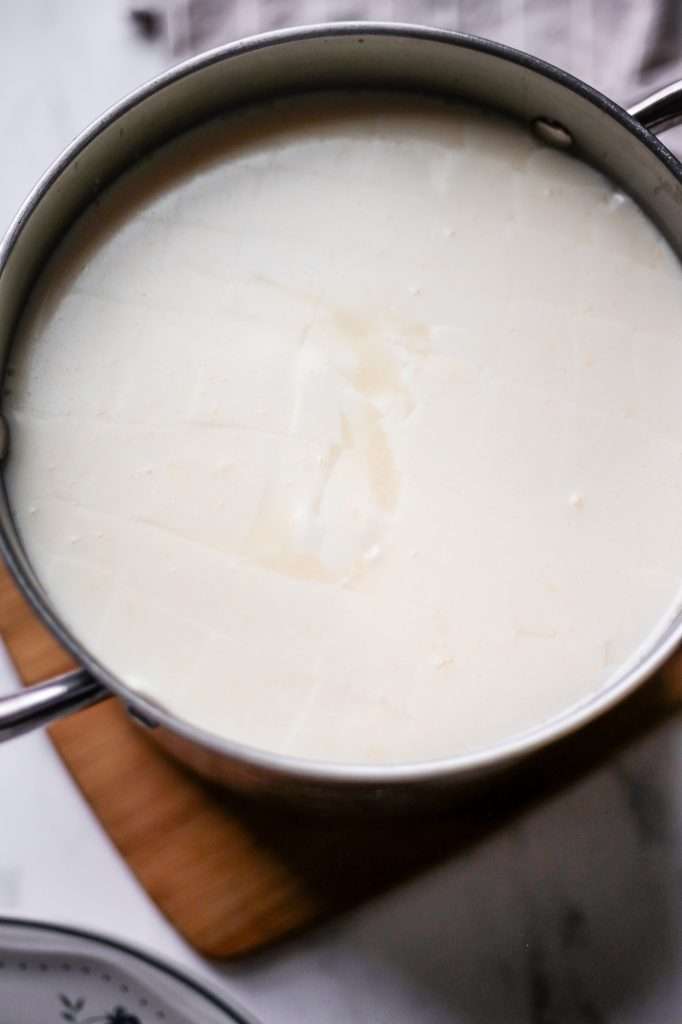
Check for a Clean Break and Cut the Curds
After 1 hour, check for a clean break: slice the curd once and pull it back with the knife. You should see whey fill the crack and your knife should be clean. If you do not have a clean break, let it sit for 30 more minutes, then check again.
Once you have a clean break, cut the curd into 1/2-inch cubes, then let them heal for five minutes.
Gently and slowly stir the curds through for five minutes, then rest for 20 minutes. Then repeat once more (stir gently for 5 minutes, rest for 20 minutes).
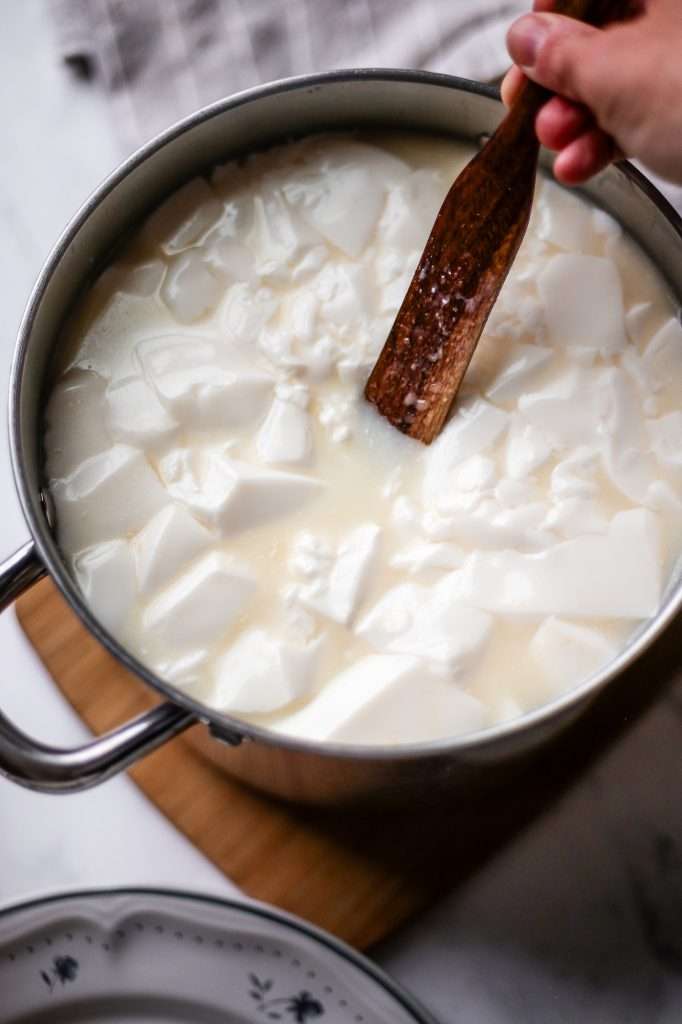

Line a colander with butter muslin, ensuring you have enough cloth to tie. Gently drain the curds into the colander (place a large pot under the colander if you plan to reserve the whey).
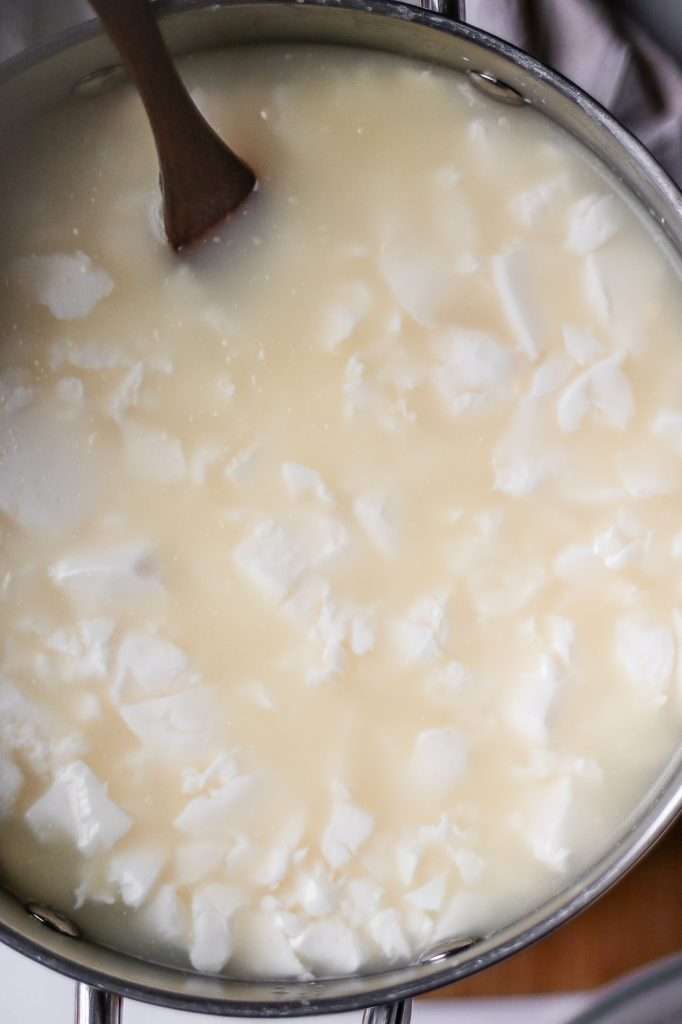

Tie the butter muslin with the cheese curds inside to make a pouch. Hang the pouch of cheese to drain for 16 hours.
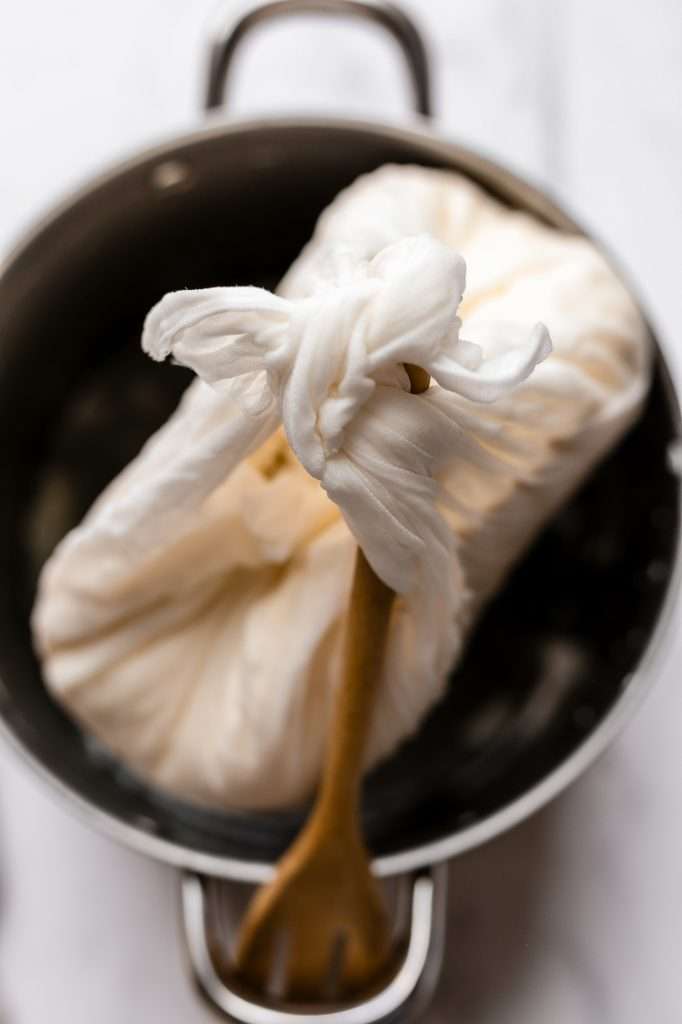
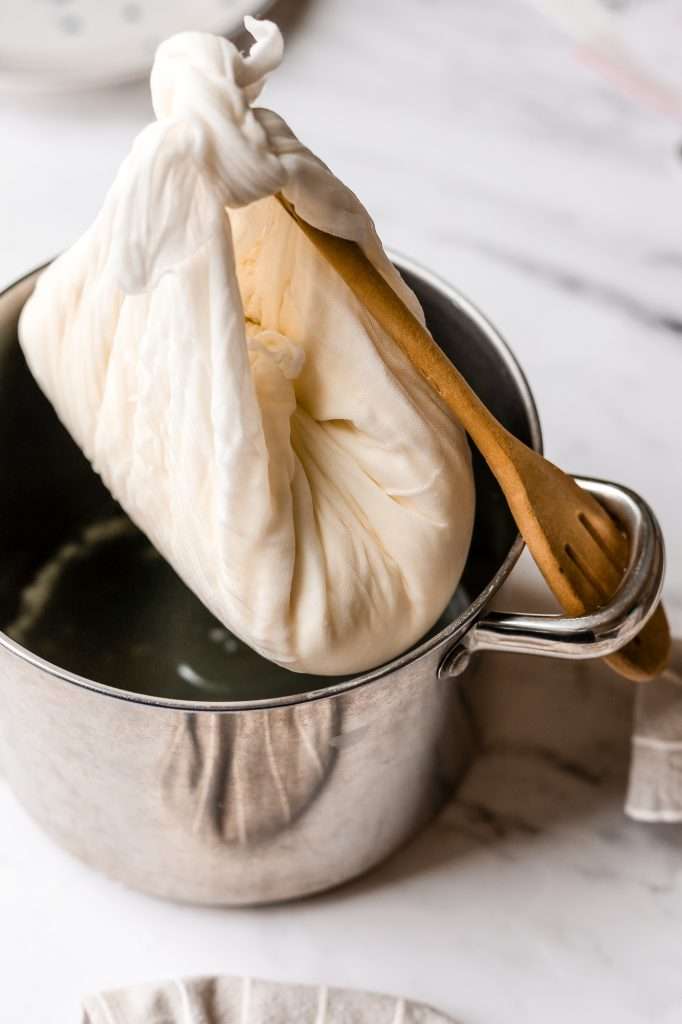
After hanging the cheese
The next day, (with clean hands) unwrap the cheese from the cloth and cut it into cubes. Go ahead and place a clean colander over a bowl and drape the butter muslin over the colander. Gently toss the cheese in 15 grams of sea salt, coating all the cheese in salt. Place the salted cheese cubes in the butter muslin-lined colander. Fold the cloth over the cheese and place it in the fridge to drain and age for 72 hours.

After 72 hours, make the herbed 8% salt brine: in a pot, heat 550 milliliters of water, 50 milliliters lemon juice, and 50 grams of sea salt. Bring to a boil. While boiling, add the optional herbs. The amount is up to you; the more you add, the stronger the flavor. Adding some herbaceous flavor to the cheese doesn’t take much, so start small. After adding the herbs, simmer for about 10 minutes.
Allow the brine to cool completely to room temperature. Take the cheese from the fridge and let it come to room temperature. The cheese and brine must be at the same temperature. Add the cheese to a quart mason jar and pour the brine over the cheese so it’s completely covered. Put lids on the jars and age them in the fridge for 24-72 hours before enjoying.
And with that, you just learned how to make feta cheese!

How to Make Feta Cheese with Goat Milk
I have great news for you if you’re wondering how to make feta cheese with goat milk. You follow the exact directions to make feta cheese with goat milk! You can also try a mix of goat and cow milk, which I often make.
How Healthy is Feta Cheese?
Feta cheese offers several health benefits:
- Rich in Nutrients: Feta cheese is a good source of calcium, phosphorus, and B vitamins, which are essential for bone health, energy metabolism, and various bodily functions.
- Probiotics: This homemade variety of feta contains probiotics, beneficial bacteria that can promote gut health. These probiotics can aid in digestion and improve gut flora.
- Conjugated Linoleic Acid (CLA): Feta contains conjugated linoleic acid, a type of fatty acid linked to various health benefits.
- Bone Health: The high calcium content in feta is excellent for maintaining strong bones and teeth. It also contains phosphorus, which works with calcium to enhance bone health.
- Source of Protein: Feta provides a good amount of protein, essential for muscle maintenance, repair, and overall body function.
- Contains Beneficial Fats: Although feta has a lower fat content, the fats it incorporates are primarily saturated and monounsaturated, which can be beneficial.
It’s important to note that while feta cheese offers these health benefits, it is also high in sodium and should be consumed in moderation. As with any food, the key to gaining the most health benefits lies in consuming it as part of a balanced diet.

Starter Cultures and Supplies
- feta cheese cultures
- lipase
- liquid animal rennet
- butter muslin (fine cheesecloth)
The Best Milk For Making Feta Cheese
Fresh milk from a local, trusted farm in your area is always the best to use in fermentation. I know that can sometimes be hard to get a hold of, so rest assured that store-bought milk works great.
Make sure it’s high quality, organic, non-homogenized and from grass-fed animals. While it is possible to use homogenized milk, I do not recommend it.
Here is the list of milk brands I can easily find in my area (Louisiana) that I love to use:
- Kalona SuperNatural
- Feliciana Creamery
More Fermented Dairy Recipes
- Raw Milk Yogurt Instant Pot Recipe an Easy Plain Whole Milk Yogurt
- Homemade Cultured Butter with Lemon and Herbs
- How to Make Fermented Milk Kefir at Home

How to Make Feta Cheese From Scratch with Cow or Goat Milk
Savor the rich, creamy texture of homemade feta. Learn how to make feta cheese from scratch. Aged to tangy perfection, it’s a delightful addition to salads, pastas, and your favorite dishes.
- Prep: 3 hours
- Cook: 15 minutes
- Total Time: 99 hours 15 minutes
Ingredients
- One gallon non-homogenized whole milk*
- 1 packet feta cheese cultures
- 1/2 teaspoon lipase
- 1/2 teaspoon liquid rennet
- Filtered water
- Sea salt
- Lemon juice
Optional Brine Ingredients
- Peppercorns
- rosemary
- Red pepper flakes
- Basil
- thyme
- Minced garlic
Instructions
- You will see a lot of gently stir directions in this recipe, that means stir slowly and avoid making bubbles.
- Heat one gallon of milk over low heat to 86° F (30° C).
- While waiting for your milk to heat, add 1/2 teaspoon lipase to 1/4 cup filtered water, stir to dissolve.
- When the milk reaches 86° F (30° C) turn off the heat, and gently stir in the lipase mixture; stir for 30 seconds.
- Sprinkle 1 packet of feta cheese cultures over the top of the milk, then gently stir the cultures into the milk for 1 minute.
- Place a lid on the pot then wrap the pot in a warm towel or blanket to maintain a warm temperature. Let the pot sit undisturbed for 2 hours.
- After 2 hours, dilute 1/2 teaspoon liquid rennet in 2 tablespoons of filtered water.
- Add the diluted rennet to the milk mixture and stir with a very gentle up and down motion for no more than 30 seconds.
- Place the lid back on the pot and then wrap the pot in a warm towel or blanket to maintain a warm temperature.
- Let the pot sit undisturbed for 1 hour.
- After 1 hour, check for a clean break: slice the curd once and pull it back a little with the knife. You should see whey fill the crack and your knife should be clean. If you do not have a clean break yet, let it sit for 30 more minutes then check again.
- Cut the curd into 1/2 inch cubes, then let them heal for five minutes.
- Gently and slowly, stir the curds all the way through for five minutes, then rest for 20 minutes. Then repeat once more (stir gently for 5 minutes, rest for 20 minutes).
- Line a colander with butter muslin, making sure you have enough cloth draped to tie the ends together. Gently drain the curds into the cloth lined colander (place a large pot under the colander to reserve the whey, you will need it to make the brine).
- Tie the butter muslin with the cheese curds inside to make a pouch. Hang the pouch of cheese to drain for 16 hours.
- The next day, (with clean hands) unwrap the cheese from the cloth and cut it into cubes. Go ahead and place a clean colander over a bowl and drape the butter muslin over the colander.
- Gently toss the cheese in 15 grams of sea salt, coating all the cheese in salt.
- Place the salted cheese cubes in the butter muslin lined colander. Fold the cloth over the cheese and place it in the fridge to drain and age for 72 hours.
- After 72 hours, make the 8% salt brine: in a pot, heat 550 milliliters of whey, 50 milliliters lemon juice, and 50 grams of sea salt. Bring to a boil.
- While boiling add the optional herbs. The amount is up to you, the more you add the stronger the flavor. It doesn’t take much to add some herbaceous flavor to the cheese, so start small. After adding the herbs simmer for about 10 minutes.
- Allow the brine to cool completely to room temperature.
- Take the cheese out of the fridge and let it come to room temperature. The cheese and brine must be the same temperature.
- Add the cheese to a quart mason jar and pour the brine over the cheese so it’s completely covered.
- Put a lid on the jar and place it in the fridge for 24 hours before enjoying it.
- Keep the cheese in the brine and keep it refrigerated.
Notes
- You can use store-bought milk or farm-fresh milk. If using store-bought, use 2% or whole milk that is low-temp pasteurized, and non-homogenized. While it is possible to use homogenized milk I do not recommend it. I use Kalona Supernatural brand milk.
- You can also use fresh raw milk in this recipe, but if you do, you should age the cheese in the brine in the fridge for about 2 months before eating.
- Use cow, goat, or sheep milk in this recipe. A mix of milk works great too.
















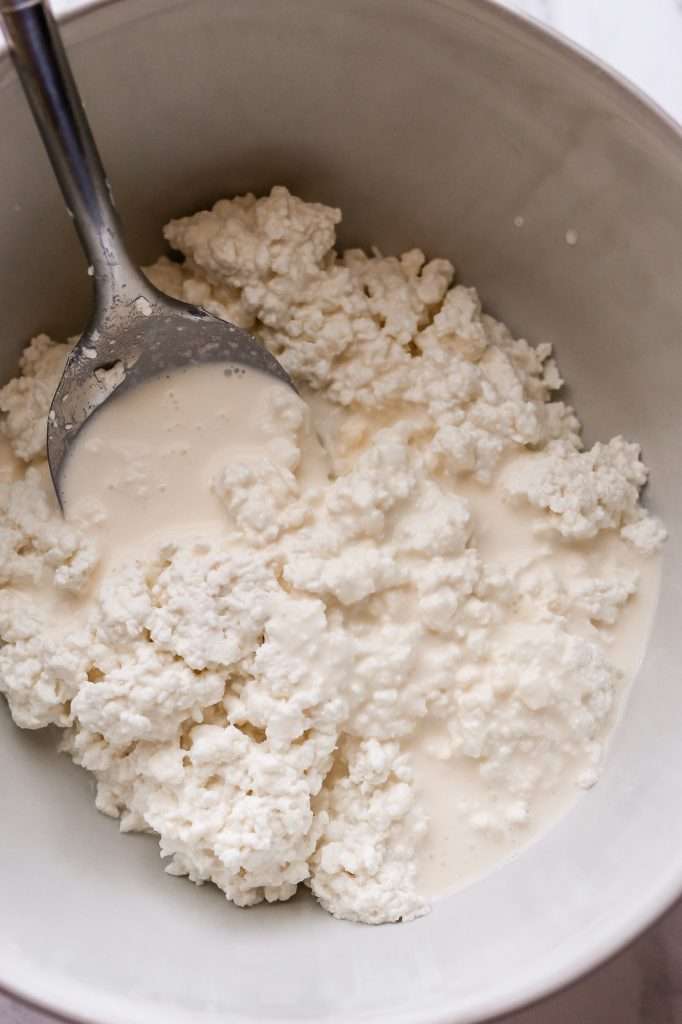
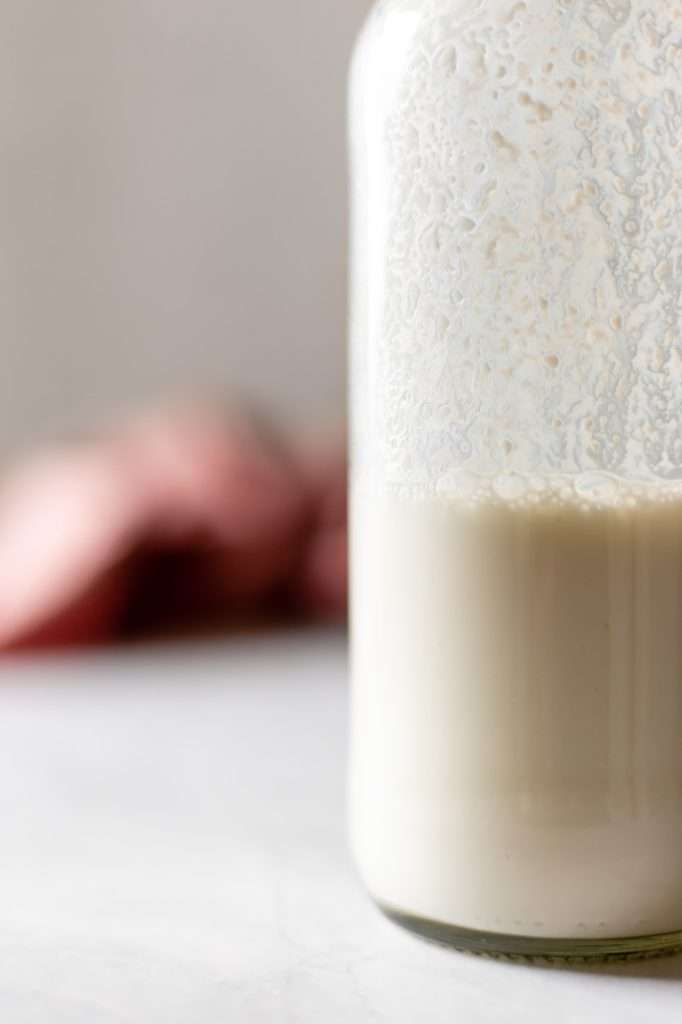

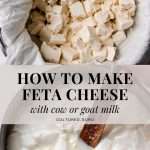
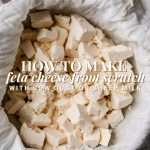
I made this recipe this past week.
It’s a no fail recipe, just like the rest of her recipes. Love them all!
The flavor is amazing before brining. It’s now sitting in the brine and I can’t wait to try!!
yay! so glad you liked the recipe!
Looks amazing I want to try it! Will raw milk work the same in this recipe? And instead of the butter muslin to drain, would a yogurt strainer container work ok?
yes! Raw milk will work, you just need to age it a little longer. Check the notes at the bottom of the recipe for details. And I think a yogurt strainer should work great.
Hiiiii just made the recipe and I’m so excited to try it once it finishes brining! Just to confirm, how long will the feta last on the fridge?
It should last a long while. I’ve never kept it long enough for it to go bad. It definitely lasts 6 months, probably longer.
I’ve made this recipe twice now! First time with raw goat milk and sheep milk, and now trying with store bought non-homogenized whole milk and goat milk. Waiting to pour the brine on it right now. If you want to get really fancy, try adding a little crushed saffron to the brine – so good! Thanks Kaitlynn!!
Thank you for leaving a review! I’m thrilled to hear that the recipe is working great for you!